Teachers Online Research Full Report K-12
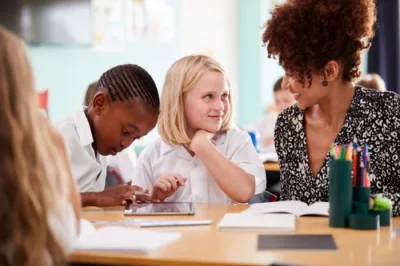
A recent look at K-12 teachers from OvationMR’s online panel study of American teachers
American Teachers Really Like Their Jobs
Teachers survey reveals: Unlike government, school leadership while government is seen as unsupportive.
In a recent K-12 Teacher online panel study American teachers generally report strong job satisfaction as 56% report liking their jobs a great deal and over 90% liking it a good amount.
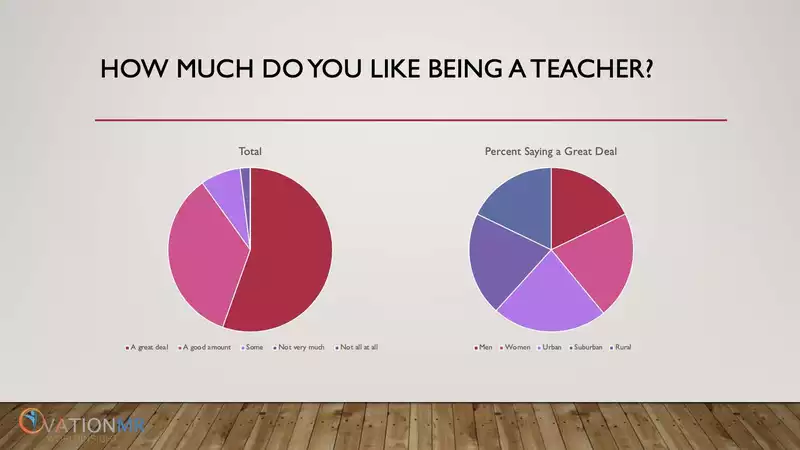
| How much do you like being a teacher? | Total |
| A great deal | 56% |
| A good amount | 35% |
| Some | 8% |
| Not very much | 2% |
| Not all at all | 0% |
Women, older teachers, and urban teachers like being teachers somewhat more than their male, younger, and rural counterparts.
| How much do you like being a teacher? | % Saying a Great Deal |
| Men | 48% |
| Women | 57% |
| Urban | 61% |
| Suburban | 55% |
| Rural | 48% |
On balance more teachers like their job more now than they did three years ago. Teachers in affluent areas are more apt to like teaching more than they did three years ago.
| Do you like teaching more, less or about the same as you did three years ago? | Total | Affluent | Not so Affluent |
| More | 34% | 42% | 30% |
| Less | 25% | 17% | 29% |
| About the same | 37% | 34% | 38% |
| Wasn’t teaching three years ago | 5% | 7% | 3% |
3 in 5 would recommend teaching to recent graduates.
| To what extent would you recommend teaching as a profession to recent graduates? | Total |
| Definitely would | 30% |
| Probably would | 30% |
| Might or might not | 22% |
| Probably would not | 12% |
| Definitely would not | 6% |
Teachers give outstanding marks to their students, but a majority also like their administration and district.
| How much do you like each of the following? | Your students | Your administration | Your district |
| A great deal | 61% | 30% | 28% |
| A good amount | 31% | 36% | 39% |
| Some | 6% | 20% | 24% |
| Not very much | 1% | 11% | 8% |
| Not all at all | 0% | 2% | 2% |
After their families who are generally seen to provide overwhelming support, teachers feel most supported by their administration in the form of their principal, vice-principals, and department leaders in addition to their students.
Government at every level is seen as providing weak support by an overwhelming number of teachers as fewer than 3 in 10 see federal, state and local government as providing excellent or very good support.
Parents lag behind administrators in providing support, but are no as bad as the various levels of government.
| How would you rate the support you receive from each of the following to do your job effectively? | Excellent | Very good | Good | Fair | Poor |
| Your family | 56% | 28% | 13% | 4% | 0% |
| Your principal | 38% | 23% | 20% | 12% | 8% |
| Your students | 31% | 34% | 25% | 8% | 1% |
| Your department leader | 30% | 33% | 26% | 9% | 3% |
| Your vice-principals | 27% | 29% | 24% | 14% | 6% |
| The school superintendent | 21% | 23% | 29% | 19% | 8% |
| Parents of children in your class(es) | 16% | 29% | 33% | 16% | 6% |
| The Board of Education | 13% | 24% | 31% | 22% | 10% |
| The local government | 8% | 19% | 35% | 26% | 12% |
| The federal government | 5% | 13% | 26% | 30% | 26% |
| The state government | 5% | 16% | 30% | 27% | 22% |
Teachers Are Most Concerned About Funding/Budget Cuts, Poverty & Standardized Testing
The top concerns that teachers have about their current situation are funding/budget cuts, standardized testing, poverty and bullying.
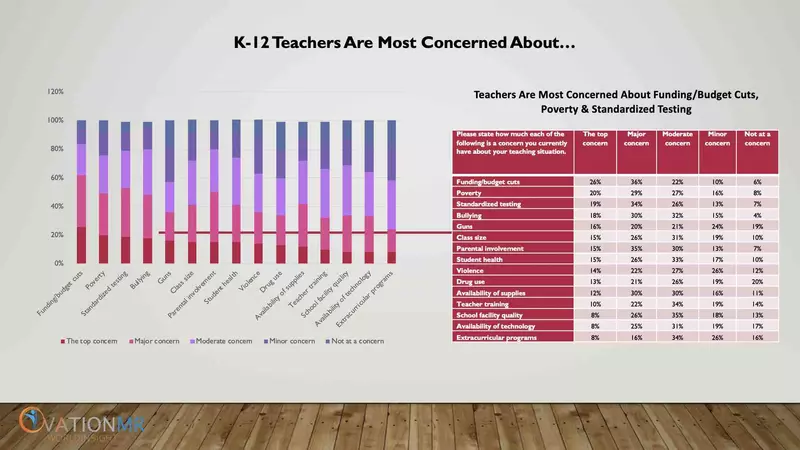
| Please state how much each of the following is a concern you currently have about your teaching situation. | The top concern | Major concern | Moderate concern | Minor concern | Not at a concern |
| Funding/budget cuts | 26% | 36% | 22% | 10% | 6% |
| Poverty | 20% | 29% | 27% | 16% | 8% |
| Standardized testing | 19% | 34% | 26% | 13% | 7% |
| Bullying | 18% | 30% | 32% | 15% | 4% |
| Guns | 16% | 20% | 21% | 24% | 19% |
| Class size | 15% | 26% | 31% | 19% | 10% |
| Parental involvement | 15% | 35% | 30% | 13% | 7% |
| Student health | 15% | 26% | 33% | 17% | 10% |
| Violence | 14% | 22% | 27% | 26% | 12% |
| Drug use | 13% | 21% | 26% | 19% | 20% |
| Availability of supplies | 12% | 30% | 30% | 16% | 11% |
| Teacher training | 10% | 22% | 34% | 19% | 14% |
| School facility quality | 8% | 26% | 35% | 18% | 13% |
| Availability of technology | 8% | 25% | 31% | 19% | 17% |
| Extracurricular programs | 8% | 16% | 34% | 26% | 16% |
- Nearly 4 in 5 teachers (79%) think that parents need to become more actively involved in their children’s education as more teachers disagree (44%) than agree (38%) that students arrive in their classroom academically prepared for their grade level.
- 62% agree students should be more aggressively grouped to classes by their academic abilities.
- 3 in 5 (60%) say that all students should be prepared to go to college.
- Teachers are divided on whether students have too much homework. 33% agree and 37% disagree.
- Teachers say both administrators and teachers need to do more to protect students from violence. 62% of teachers agree that administrators need to do more and 49% say they need to do more to protect students from violence
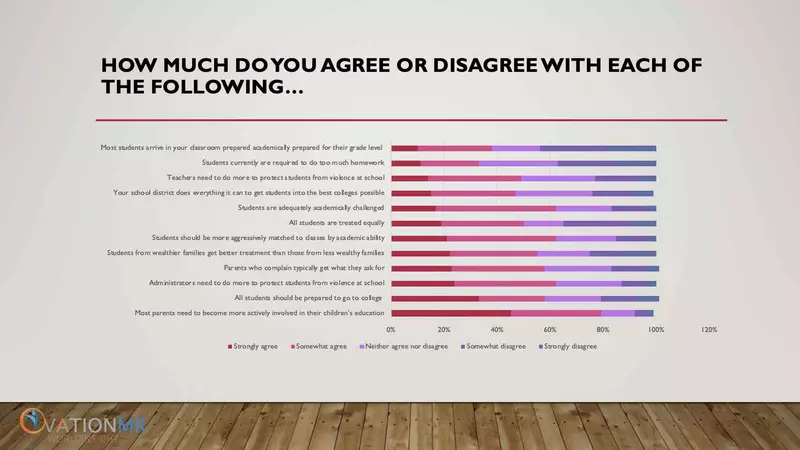
- Nearly 4 in 5 teachers (79%) think that parents need to become more actively involved in their children’s education as more teachers disagree (44%) than agree (38%) that students arrive in their classroom academically prepared for their grade level.
- 62% agree students should be more aggressively grouped to classes by their academic abilities.
- 3 in 5 (60%) say that all students should be prepared to go to college.
- Teachers are divided on whether students have too much homework. 33% agree and 37% disagree.
- Teachers say both administrators and teachers need to do more to protect students from violence. 62% of teachers agree that administrators need to do more and 49% say they need to do more to protect students from violence
| Please state how much do you agree or disagree with each of the following statements. | Strongly agree | Somewhat agree | Neither agree nor disagree | Somewhat disagree | Strongly disagree |
| Most parents need to become more actively involved in their children’s education | 45% | 34% | 13% | 5% | 2% |
| All students should be prepared to go to college | 33% | 25% | 21% | 14% | 8% |
| Administrators need to do more to protect students from violence at school | 24% | 38% | 25% | 9% | 4% |
| Parents who complain typically get what they ask for | 23% | 35% | 25% | 13% | 5% |
| Students from wealthier families get better treatment than those from less wealthy families | 22% | 33% | 20% | 14% | 11% |
| Students should be more aggressively matched to classes by academic ability | 21% | 41% | 23% | 11% | 4% |
| All students are treated equally | 19% | 31% | 15% | 26% | 9% |
| Students are adequately academically challenged | 17% | 45% | 21% | 14% | 3% |
| Your school district does everything it can to get students into the best colleges possible | 15% | 32% | 29% | 16% | 7% |
| Teachers need to do more to protect students from violence at school | 14% | 35% | 28% | 16% | 7% |
| Students currently are required to do too much homework | 11% | 22% | 30% | 23% | 14% |
| Most students arrive in your classroom prepared academically prepared for their grade level | 10% | 28% | 18% | 26% | 18% |
Teachers Follow University Admissions Scandal Closely.
The Scandal Surprises Few Teachers 3 in 5 Teachers Believe At Least Some Parents in Their District Would Go to Such Lengths
An online research study shows the university admissions scandal is being followed closely by most teachers. Over 1 in 3 (35%) have heard a great deal about it, while only 16% have heard not very much or nothing at all about it.
Older teachers are more likely to have heard a great deal about the scandal than younger ones, while teachers teaching in affluent areas are less likely to have heard a great deal or good amount about it.
| How much did you hear or read anything about the indictment of 50 people for their role in paying to get students into prestigious universities? | Total | Age | Affluence | ||||
| Under 30 | 30-39 | 40-49 | 50 or older | Affluent | Not so affluent | ||
| A great deal | 35% | 21% | 34% | 38% | 45% | 32% | 36% |
| A good amount | 28% | 35% | 28% | 23% | 26% | 25% | 30% |
| Some | 21% | 24% | 19% | 24% | 20% | 25% | 20% |
| Not very much | 11% | 9% | 13% | 13% | 7% | 12% | 11% |
| Nothing at all | 5% | 11% | 5% | 1% | 2% | 7% | 4% |
Online Research - OvationMR - Copyright 2019 All Rights Reserved.
The story came as a surprise to less than 1 in 4 (22%) teachers.
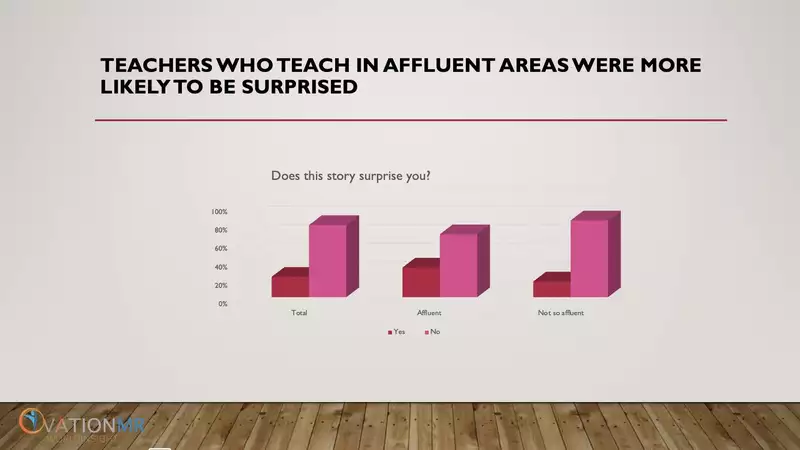
| Does this story surprise you? | Total | Affluent | Not so affluent |
| Yes | 22% | 32% | 17% |
| No | 78% | 68% | 83% |
Online Research Reveals More Differences in Teachers of Affluent/NonAffluent Students
25% of teachers say about half or most parents in their district would go to such lengths to get their children into prestigious schools. A clear majority (59%) say at least some parents would go to such lengths. Teachers in affluent districts were more likely to say that parents in their districts would take such actions.
| What proportion of parents in your district would be willing to go to such lengths to get their children to prestigious schools? | Total | Heard a Great Deal | Surprised | Not Surprised | Affluent | Not So Affluent |
| Most (>=60%) | 9% | 11% | 14% | 8% | 17% | 5% |
| About half (40-59%) | 16% | 18% | 26% | 13% | 22% | 13% |
| Some (10-39%) | 34% | 34% | 29% | 35% | 36% | 33% |
| A few (Less than 10%) | 34% | 30% | 26% | 36% | 22% | 40% |
| None | 7% | 7% | 4% | 8% | 3% | 9% |
Online Research - OvationMR - Copyright 2019 All Rights Reserved.
3 in 4 Teacher Consider Themselves Underpaid, A 20% Raise Would Likely Be Adequate
The median teacher makes between $50,000 & $60,000 per year. 70% of all teachers make between $30,000 and $70,000 or year. Older teachers have higher salaries due to their longer tenure and experience. Rural teachers tend to have lower salaries than their urban and suburban counterparts.
| Into which category does your annual teaching salary fall into? | Total | Under 30 | 30-39 | 40-49 | 50 or older | Urban | Suburban | Rural |
| Under $20,000 | 1% | 0% | 2% | 0% | 0% | 2% | 0% | 0% |
| $20,000 to $29,999 | 4% | 13% | 4% | 1% | 0% | 2% | 5% | 5% |
| $30,000 to $39,999 | 15% | 26% | 16% | 9% | 10% | 14% | 12% | 25% |
| $40,000 to $49,999 | 21% | 23% | 25% | 21% | 15% | 21% | 20% | 26% |
| $50,000 to $59,999 | 21% | 20% | 19% | 24% | 21% | 24% | 20% | 18% |
| $60,000 to $69,999 | 14% | 9% | 17% | 12% | 16% | 12% | 17% | 10% |
| $70,000 to $79,999 | 8% | 3% | 8% | 10% | 9% | 7% | 8% | 8% |
| $80,000 to $89,999 | 6% | 3% | 4% | 12% | 7% | 9% | 6% | 1% |
| $90,000 or more | 8% | 3% | 4% | 10% | 16% | 7% | 9% | 5% |
| Would rather not say | 2% | 3% | 1% | 1% | 5% | 2% | 3% | 1% |
Just over 3 in 4 teachers consider themselves to be underpaid.
Despite receiving higher salaries than their younger proteges, older teachers are disproportionately likely to think they are underpaid.
Rural teachers, who generally receive lower salaries are more apt to think they are underpaid.
Additionally, teachers who predominantly teach students from less affluent families are also more likely to think they are underpaid.
| For your teaching work, do you consider yourself to be… | Total | Under 30 | 30-39 | 40-49 | 50 or older | Urban | Suburban | Rural | Affluent | Not so affluent |
| Strongly underpaid | 33% | 26% | 28% | 39% | 42% | 33% | 30% | 39% | 25% | 37% |
| Somewhat underpaid | 43% | 44% | 53% | 39% | 29% | 44% | 44% | 43% | 43% | 43% |
| Fairly paid | 21% | 26% | 16% | 20% | 29% | 19% | 24% | 17% | 27% | 19% |
| Somewhat overpaid | 2% | 4% | 2% | 1% | 0% | 4% | 0% | 1% | 3% | 1% |
| Strongly overpaid | 1% | 0% | 1% | 1% | 0% | 0% | 1% | 0% | 2% | 0% |
The median percentage raise underpaid teachers said they needed to get to be paid adequately was 20 percent. The media was slightly lower, 15%, for better compensated groups of teachers including teachers 50 and over, suburban teachers and those who primarily teach students from affluent families.
| IF UNDERPAID: What percentage raise would you have to get in order for you to be paid adequately? |
| Median: 20% |
Teachers, despite being underpaid, typically spend $300 of their own money on school supplies, signaling their dedication to their students.
| How much of your own money do you spend on supplies for your students every year? |
| Median: $300 |
The majority (62%) who spend their own money on supplies do take advantage of the tax deduction for them, but another 38% do not.
| Do you deduct these expenses from your taxes? | Teachers Who Buy Supplies |
| Yes | 62% |
| No | 38% |
Majority of US school shootings are perpetrated by members of the school community**. Still most K-12 teachers believe threats come from outsiders an online teacher study reveals.
The online research study found most teachers (62%) see outsiders as a bigger safety threat than members of the school community.
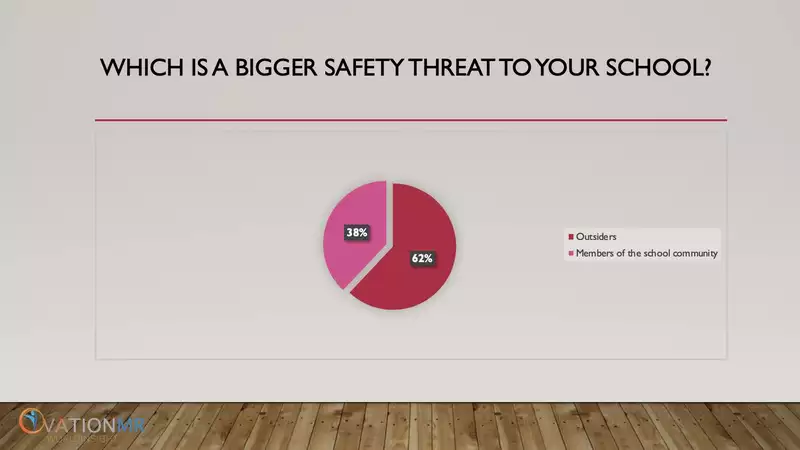
Bar
| Outsiders | 62% |
| Members of the school community | 38% |
A majority of teachers (56%) have a minor police presence at their school.
| How would you characterize the police presence in your school? | Total |
| Major presence | 18% |
| Minor presence | 56% |
| No presence | 26% |
Over 7 in 10 teachers think it is appropriate for police to be armed with guns at school. Private school teachers were somewhat less likely to welcome armed police including support for 2 in 3 teachers who identify as Democrats according to this online teacher panel study.
Support for armed police is lower at private schools.
Total
Party ID
School Type
Republican
Independent
Public
Private
71%
69%
80%
66%
74%
50%
29%
31%
20%
34%
26%
50%
| Do you think it is appropriate to have police armed with guns at your school? | ||
| Democrat | Yes | No |
In contrast to armed police, only roughly 1 in 4 (26%) teachers think it’s appropriate for some well-trained teachers to carry guns at school. This issue divides across typical political and regional lines with Republicans and rural teachers more apt to support such a policy.
| Do you think it is appropriate for some well-trained teachers to carry guns in your school? | Total | Party ID | Region | ||||
| Democrat | Republican | Independent | Urban | Suburban | Rural | ||
| Yes | 26% | 17% | 44% | 23% | 24% | 24% | 36% |
| No | 74% | 83% | 56% | 77% | 76% | 76% | 64% |
Sadly, 3 in 4 teachers report their schools participate in active shooter drills in the aftermath of such school shootings in Columbine, CO and Parkland, FL.
| Does your school participate in active shooter drills? | Total |
| Yes | 76% |
| No | 24% |
Bart Borkosky is Chief Research Officer at OvationMR and is responsible for Research Design and Online Sample Data Quality. He also consults with clients on sampling design for various types of online research campaigns and political polling. Bart can be reached at bart.borkosky@ovationmr.com
To learn more about OvationMR Online Teacher Panel solutions or our other Online Sampling and our online methodology for ensuring your success you can visit Panel Quality & Recruitment or Download 2021 PanelBook and/or contact us at info@ovationmr.com
** Naval Postgraduate School’s Center for Homeland Defense K-12 schools shooting database
